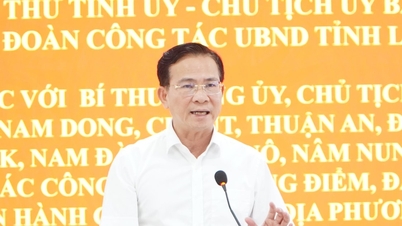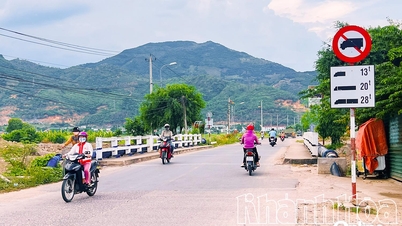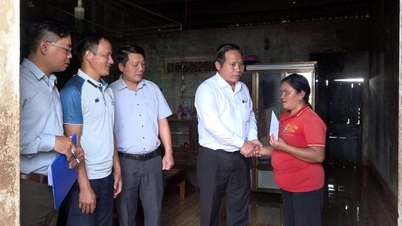Filling the funding gap for infrastructure projects
In the context that Vietnam is promoting the construction of large-scale national infrastructure, but the state budget is still lacking and the bank credit channel is limited in financing infrastructure projects, Vietnam will need to mobilize long-term private capital, in which corporate bonds are emerging as a capital mobilization channel to compensate for this gap.
Speaking at the Bond Highlights Newsletter , Mr. Duong Duc Hieu - Director - Senior Expert of VIS Rating said that in the period of 2025-2030, Vietnam is estimated to need about 250 billion USD for investment in infrastructure projects such as high-speed railways, energy projects, etc. and public investment capital can only meet about 70% of capital needs with announced public investment plans.
 |
| Mr. Duong Duc Hieu - Director - Senior Expert VIS Rating |
In addition, a relatively important source of capital for infrastructure development in the past was bank credit, which will soon be tightened in its use for infrastructure capital through financial safety indicators, such as the use of short-term capital for medium and long-term loans.
According to VIS Rating statistics, the scale of outstanding loans from banks for projects, such as road traffic projects, has decreased recently. Over the past 3 years, this outstanding loan scale has decreased by an average of about 10%, so bank credit is no longer an abundant source of capital for developing infrastructure projects.
“Therefore, to fill this capital gap, we believe that infrastructure bonds will be a very suitable product to finance upcoming infrastructure projects in Vietnam,” Mr. Duong Duc Hieu affirmed.
Mr. Hieu also recalled the past story with the story of Vietnam's growth since the opening of the door to innovation. The main source of capital for Vietnam to develop infrastructure during this period was the state budget and ODA capital to support development, followed by bank credit. With the current development of Vietnam, ODA capital is no longer as abundant as before. Next, in the past there were also periods of very high credit growth, but even during the period of strong credit promotion, GDP never reached double digits - the target that we are expecting in the near future.
Therefore, to achieve this goal, it is clear that the requirement is to develop new capital channels for the economy and the market. Mr. Hieu believes that the bond channel, especially long-term infrastructure bonds, will be a new capital channel and a new pillar alongside the state budget and bank credit sources in investing in Vietnam's infrastructure development.
“We also hope that in the near future, state agencies, especially the Ministry of Finance, will issue more policies to support and develop this market,” Mr. Hieu hopes.
In the context of regulatory agencies making efforts to develop new products for the market, VIS Rating experts also forecast that the development of the bond market will accelerate more strongly. In 2026 and the coming years, the bond market will enter a new, much more positive development cycle after recovering from the bottom in the past 2 years.
Demand for infrastructure bonds is huge
Assessing the prospects for infrastructure bonds, Mr. Duong Duc Hieu noted the market's strengths as Vietnam has political , economic, and security stability, along with a story about strong infrastructure development goals in the next 5 years.
Investing in infrastructure projects will take decades, so political and economic stability is a prerequisite.
This expert said that developed countries have a typical way of financing infrastructure projects and it has actually been applied to a power project in Vietnam with an investor from the US. Specifically, during the initial project development period, the project used borrowed capital and after the power project was successfully built and generated electricity for about 4 years, the investor issued a 10-year bond package with fixed interest rate and to restructure the capital source, pay off the old debt and restructure it with a bond with fixed interest rate and long term.
This example shows how developed countries use infrastructure bonds, which is that the investor will use bank capital in the early stages of the project - the development stage. At this time, the main cash flow is investment, the bank will be the party with enough resources and can manage the risks related to the cash flow as well as investment activities. After the project is put into stable operation, has stable cash flow, helping the project's credit rating to be relatively high, this stage will be very suitable for restructuring the project's capital source with long-term bonds and lower interest rates.
Currently in Vietnam, the law does not allow some investors such as banks or life insurance companies - units with long-term capital sources - to participate in buying bonds for the purpose of debt restructuring. However, recently, the Ministry of Finance has had a roadmap for developing the Vietnamese securities investment management industry, including a proposal to allow insurance companies to buy refinanced and restructured bonds. This is a point to help expand the investor base for infrastructure bonds in the future.
In fact, the potential for mobilizing capital through infrastructure bonds in the population, insurance sectors, investment funds, pension funds, etc. is still very large in Vietnam.
As for bond funds, from the crisis bottom in 2023, the total asset value has doubled, but the demand for bond investment has not been met. Some fund managers shared that they do not have enough resources to buy for these bond funds. Most of the assets of bond funds are still in the form of bank bonds or certificates of deposit. In addition, some other potential buyers of infrastructure bonds such as life insurance units, the total assets of this group also grow steadily...
“Therefore, the potential demand for infrastructure bonds is huge, and I believe that when new policies are issued and issuance activities are activated, this demand will be met in the near future,” Mr. Hieu expects.
Source: https://baodautu.vn/trai-phieu-ha-tang-ky-vong-tro-thanh-kenh-tru-cot-dan-von-moi-cho-nen-kinh-te-d423460.html



![[Photo] Prime Minister Pham Minh Chinh attends the annual Vietnam Business Forum](https://vphoto.vietnam.vn/thumb/1200x675/vietnam/resource/IMAGE/2025/11/10/1762780307172_dsc-1710-jpg.webp)


![[Photo] Prime Minister Pham Minh Chinh attends the Patriotic Emulation Congress of the Ministry of Foreign Affairs for the 2025-2030 period](https://vphoto.vietnam.vn/thumb/1200x675/vietnam/resource/IMAGE/2025/11/10/1762762603245_dsc-1428-jpg.webp)




























































































![Dong Nai OCOP transition: [Article 3] Linking tourism with OCOP product consumption](https://vphoto.vietnam.vn/thumb/402x226/vietnam/resource/IMAGE/2025/11/10/1762739199309_1324-2740-7_n-162543_981.jpeg)










Comment (0)